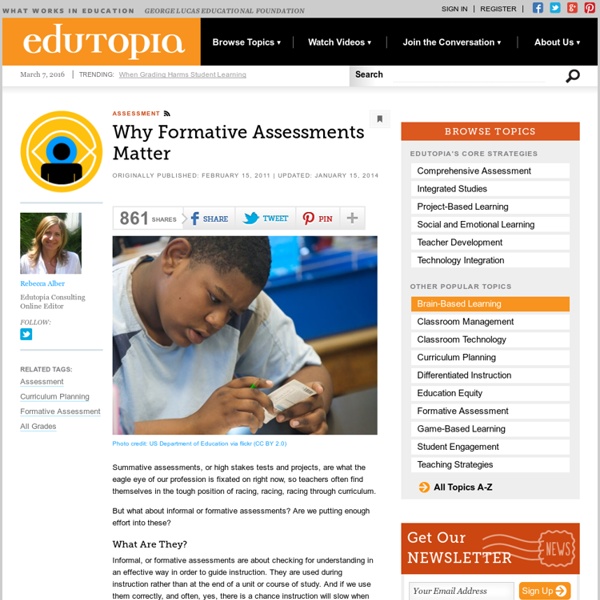Formative assessment
Formative assessment is a process used by teachers and students during instruction that provides explicit feedback to adjust ongoing teaching and learning to improve students’ achievement of intended instructional outcomes. Formative assessment is a method of continually evaluating students’ academic needs and development within the classroom and precedes local benchmark assessments and state-mandated summative assessments. Teachers who engage in formative assessments give continual, explicit feedback to students and assist them in answering the following questions: Where am I going? In order to show students how to close the gap between where they are academically and where they want to be, teachers must help students evaluate their progress in the learning process and give them explicit, descriptive feedback specific to the learning task. History of formative assessments The Council of Chief State School Officers (CCSSO) developed a focus for formative assessment in October 2006.
Justification
Dissecting Formative Assessment - Post One
Dylan Wiliam has identified five strategies that he has come to believe are core to successful formative assessment practice in the classroom. Over the next five formative assessment blog posts, we’ll break each strategy down for better understanding of how it fits into the big picture of formative assessment. First, here are his five strategies: 1. Clarifying, sharing, and understanding learning intentions and criteria for success 2. 3. 4. 5. This blog will cover the first of the five strategies – clarifying, sharing, and understanding learning intentions and the criteria for success. Setting expectations is crucial in so many aspects of life, whether on the job, on the playing field, or in the classroom. In 2000, C.A. Clarifying, sharing, and understanding learning intentions and what creates success transcends teachers, students and peers.
What Are Formative Assessments and Why Should We Use Them? | Scholastic.com - Nightly
"Informative assessment isn't an end in itself, but the beginning of better instruction." —Carol Ann Tomlinson Traditionally, we have used assessments to measure how much our students have learned up to a particular point in time. This is called "assessment of learning" — or what we use to see whether our students are meeting standards set by the state, the district, or the classroom teacher. Since formative assessments are considered part of the learning, they need not be graded as summative assessments (end-of-unit exams or quarterlies, for example) are. When I work with teachers during staff development, they often tell me they don't have time to assess students along the way. Formative assessments, however, do not have to take an inordinate amount of time. Using a Variety of Formative Assessments The National Forum on Assessment (1995) suggests that assessment systems include opportunities for both individual and group work. Types of Assessment Strategies Exit Cards Thomas R.
Justification
Dissecting Formative Assessment – Post Two
In our first post in this series, we mentioned the five strategies that Dylan Wiliam has identified as core to successful formative assessment practice in the classroom. To recap they are: 1. Clarifying, sharing, and understanding learning intentions and criteria for success 2. Engineering effective classroom discussions, activities, and learning tasks that elicit evidence of learning 3. 4. 5. Our first post dissected the first strategy – clarifying, sharing and understanding learning intentions and criteria for success. In general, many classroom discussions consist of lower-order questions (closed end questions, yes/no questions) which are answered by a few motivated students. + 54% were managerial – What are you working on now? + 38% were lower-order thinking – What is war? + 8% were higher-order thinking – How might life be different if peace were declared in the Middle East? + asking higher-order questions, + collecting responses simultaneously from all students…
Justification
22 Easy Formative Assessment Techniques for Measuring Student Learning
I came across Terry Heick’s blog – 10 Assessments You Can Perform In 90 Seconds – at TeachThought from earlier this year and really enjoyed the formative assessment strategies that he outlined. Using formative assessment techniques in class – or “simple assessments” as Terry calls them – are easy to administer and provide the instant feedback teachers need to identify which students need more help, and then adjust their instruction and lesson plans to help them. Visit Terry’s blog above to get more detail on the following ten formative assessment techniques: 1. Combining Terry’s ten with the ten we’ve blogged about can give teachers 20 great formative assessment strategies for measuring student learning. 11. Here are a couple more assessments you can use to elicit evidence of student learning. 21. 22. All of these 22 formative assessment techniques are simple to administer and free or inexpensive to use. Do you have a favorite?
Justification
Assessment in the Early Childhood Classroom
Curriculum standards define what children should know and be able to do in a particular content area. Standards provide guidance to teachers and informs their instruction. Teachers can use these curriculum standards to assess what concepts need strengthening or reteaching, or to identify when a new strategy is needed. Functions of Assessment Identify current knowledge and skills of students Address and plan for the strengths and needs of students Evaluate student growth over time Promote student motivation and objectivity Evaluate program effectiveness Enlighten parents of student progress Promote parent advocates Components of Assessment Early Childhood Assessment is composed of three essential, interrelated components: Documentation (data collection) Evaluation (comparison to a standard) Communication with family (sharing both progress and performance) Documentation In documentation, emphasis is placed on discovering what a child already knows and is able to do. Evaluation
Justification



